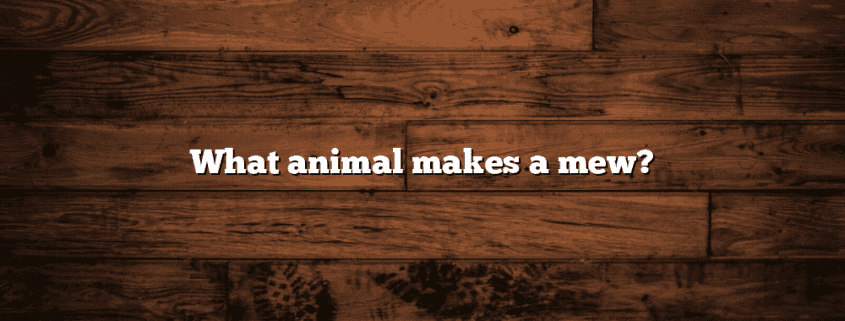What animal makes a mew?
What Animal Makes a Mew?
Have you ever heard a soft, high-pitched sound that resembles a baby’s cry? If so, you may have wondered which animal makes such a peculiar noise. This article aims to explore the fascinating world of animal vocalizations and shed light on the creature responsible for the mew sound. Through research and analysis, we will uncover the identity of this mysterious animal and delve into the reasons behind its unique vocalization.
The Mew Sound: A Closer Look
The mew sound is often described as a soft, plaintive cry that resembles the meowing of a cat. It is a high-pitched vocalization that can be heard in various environments, from urban areas to natural habitats. While many people associate the mew sound with domestic cats, there are other animals that produce similar vocalizations.
The Feline Connection: Domestic Cats
When it comes to mewing, domestic cats are the most well-known culprits. Cats use meowing as a form of communication with humans, often to express their needs or seek attention. However, it is important to note that not all cats mew in the same way. Different breeds and individual cats may have distinct variations in their vocalizations.
For example, Siamese cats are known for their loud and persistent meows, which can sound remarkably similar to a baby’s cry. This breed has a genetic predisposition for vocalization, making them more likely to produce the mew sound. Other cat breeds, such as the Burmese or Tonkinese, may also exhibit similar vocalizations.
Avian Mew: The Gray Catbird
While cats are commonly associated with the mew sound, there is an avian species that also produces a similar vocalization. The gray catbird (Dumetella carolinensis) is a medium-sized songbird found in North America. Despite its name, the gray catbird is not a feline but rather a member of the Mimidae family.
The gray catbird gets its name from its ability to mimic the sounds of other animals, including the mew sound. Its vocal repertoire includes a wide range of calls, including meows, whistles, and even the songs of other bird species. The mew sound produced by the gray catbird is believed to serve as a territorial call or a means of attracting a mate.
Other Animals That Mew
While domestic cats and gray catbirds are the most well-known animals associated with the mew sound, there are a few other creatures that produce similar vocalizations. These include:
- Bobcats: These wild felines, native to North America, emit a mew-like sound during mating season.
- Red foxes: Foxes are known for their wide range of vocalizations, including a mew-like cry.
- Ring-tailed lemurs: These primates, found in Madagascar, produce a mew-like vocalization as a form of communication.
The Purpose of Mewing
Understanding why animals mew is crucial to unraveling the mystery behind this unique vocalization. While the exact reasons may vary depending on the species, there are a few common purposes for mewing:
- Communication: Animals, such as domestic cats, use mewing as a way to communicate with humans or other members of their species.
- Expression of needs: Cats often mew to express their hunger, thirst, or desire for attention.
- Territoriality: Some animals, like the gray catbird, use mewing as a territorial call to establish their presence and ward off potential intruders.
- Mating rituals: Mewing can also serve as a means of attracting a mate during the breeding season.
Conclusion
The mew sound, often associated with domestic cats, is not limited to feline vocalizations. The gray catbird, a bird species known for its mimicry abilities, also produces a similar sound. Additionally, other animals like bobcats, red foxes, and ring-tailed lemurs have been observed emitting mew-like vocalizations. Understanding the purpose behind mewing helps us appreciate the diverse ways in which animals communicate and express themselves.
Next time you hear a mew-like sound, take a moment to consider the fascinating creatures that may be responsible for it. Whether it’s a domestic cat seeking attention or a gray catbird staking its claim, these vocalizations remind us of the rich tapestry of animal life and the many ways they communicate with the world around them.




Leave a Reply
Want to join the discussion?Feel free to contribute!